Krasnoyarsk, Krasnoyarsk, Russian Federation
The article examines the similarities in the artistic work of the great Italian Renaissance master Michelangelo (1475-1564) and the outstanding contemporary Chinese sculptor Wu Weishan (吴为山, b. 1962) from the perspective of cross-cultural comparison. Through a systematic comparison of the life path, cultural context, artistic views and plastic language of the two masters, the article reveals points of contact in such aspects as the synthesis of tradition and innovation, the expression of individual spirit and the creation of cultural symbols. Using methods of comparative analysis, the author examines in detail the ideological structure and aesthetic features of their iconic works. The aim of the article is to reveal universal ideas about “man” and common in the artistic language of different civilizations, which, in turn, can serve as a source of inspiration for the formation of cultural identity and further development of contemporary Chinese sculpture.
Michelangelo; Wu Weishan; expressive sculpture; humanistic spirit; artistic language; cultural context; sculpture aesthetics
1. Wang, Jingjing. (2015). The art of Michelangelo and the ideas of Neoplatonism (Master’s thesis, Nanjing Normal University). 50. URL: https://kns.cnki.net/KCMS/detail/detail.aspx?dbname=CMFD201601&filename=1015428986.nh. [In Chinese]
2. Li, Weikun. (1985). Self-reflection of a giant soul: Several "Pietà" sculptures by Michelangelo. Art Research, (4), 50–53. DOI: CNKI:SUN:MUSE.0.1985-04-006. [In Chinese]
3. Li, Shiqiang. (2017). Emotional expression in Xieyi sculpture (Master’s thesis, Zhengzhou University). 49. URL: https://kns.cnki.net/KCMS/detail/detail.aspx?dbname=CMFD201702&filename=1017142017.nh. [In Chinese]
4. Ma, Yuelan. (2008). Secularization of religious art: An analysis of Michelangelo’s "Moses". World Religious Culture, (1), 28–30. DOI: CNKI:SUN:RELI.0.2008-01-011. [In Chinese]
5. Xu, Tingyu. (2021). On the Sculpture Language of Wu Wei Shan ——Take "Nanjing Massacre Series Sculpture" as An Example(Master’s thesis, Liaoning Normal University). 38. DOIhttps://doi.org/10.27212/d.cnki.glnsu.2021.001154. URL: https://kns.cnki.net/KCMS/detail/detail.aspx?dbname=CMFD202102&filename=1021646563.nh. [In Chinese]
6. Tang, Shuifu. (2009). Meeting you is a great occasion: On the spiritual charm behind Michelangelo’s works. Military Journalist, (8), 33–34. DOI: CNKI:SUN:XWCC.0.2009-08-018. [In Chinese]
7. Tian, Ye. (2025). Wu Weishan: Strengthening collaboration between art and history museums to promote mutual learning among civilizations. Cultural Monthly, (3), 8. DOI: CNKI:SUN:WHYK.0.2025-03-001. [In Chinese]
8. Wu, Weishan. (2020). The cultural significance of Xieyi sculpture. Art Observation, (9), 100–105. DOI: CNKI:SUN:MSGC.0.2020-09-036. [In Chinese]
9. Wu, Weishan. (2014). Honoring souls through sculpture: Postscript on the creation of the large-scale sculpture in the Nanjing Massacre Memorial Hall. Chinese Fine Arts, (2), 38–41. DOI: CNKI:SUN:CHMS.0.2014-02-013. [In Chinese]
10. Wu, Weishan. (2011). On Xieyi sculpture. Chinese Fine Arts, (1), 38–43+163. DOI: CNKI:SUN:CHMS.0.2011-01-013. [In Chinese]
11. Wu, Qiong. (2023). The birth of new civic imagery: On Michelangelo’s "David". Chinese Journal of Art Studies, (3), 34–52. DOI: CNKI:SUN:YSQK.0.2023-03-004. [In Chinese]
12. Zhao, Fei. (2009). Michelangelo’s literary creation and Neoplatonism (Master’s thesis, Shanghai Normal University). 69. URL: https://kns.cnki.net/KCMS/detail/detail.aspx?dbname=CMFD2010&filename=2010029417.nh. [In Chinese]
13. Zheng, Jinhao. (2024). On the "unfinished" style in Michelangelo’s sculpture: A case study of the "Pietà" series. Beauty and Times (Lower), (8), 87–92. DOI:https://doi.org/10.16129/j.cnki.mysdx.2024.08.030. [In Chinese]
14. Shang, Rong. (2011). Wu Weishan’s statue "Confucius" unveiled at the National Museum of China. Ethnic Art, (1), 141. DOI:https://doi.org/10.16564/j.cnki.1003-2568.2011.01.014. [In Chinese]
15. Shan Lizhuang. (2024). Archaeological heritage of China in the work of modern Chinese sculptors. Fine Arts of the Urals, Siberia and the Far East, 3(20), 72-83. [In Russian].
16. Shan, Lizhuang. (2024). Wu Weishan: Memorial Hall for the Victims of the Nanjing Massacre during the Japanese Invasion of China. The interaction of national and Western tradition. Fine Art of the Urals, Siberia and the Far East, 1(18), 134-141. [In Russian]





